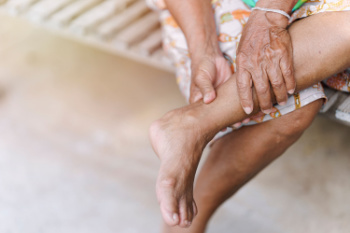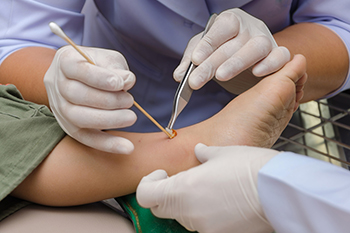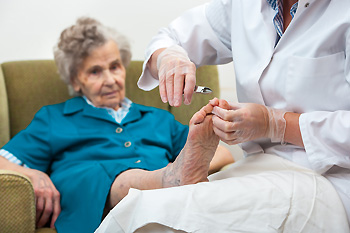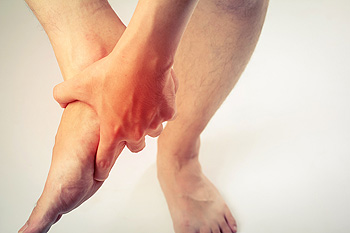Items filtered by date: November 2024
Proper Foot Care for Better Mobility

Taking care of your feet is critical for maintaining mobility, especially as we age or for those with conditions like diabetes that increase the risk of foot issues. Healthy feet support balance, movement, and independence, while neglected foot care can lead to pain, infections, or poor circulation, all of which hinder mobility. Basic foot care includes washing and drying feet thoroughly, trimming nails straight across to avoid ingrown nails, and moisturizing to prevent dry, cracked skin. Wearing well-fitting, supportive shoes also minimizes strain and prevents injuries. Regular checks for any cuts, blisters, or swelling are essential, as these can escalate if unnoticed, especially for those with diabetes. For specialized foot concerns or to prevent complications, it is suggested that you consult a podiatrist who can provide guidance, offer custom orthotics, and treat emerging issues, helping you maintain active, pain-free mobility.
Everyday foot care is very important to prevent infection and other foot ailments. If you need your feet checked, contact one of our podiatrists from Toe-tal Family Footcare Associates. Our doctors can provide the care you need to keep you pain-free and on your feet.
Everyday Foot Care
Often, people take care of their bodies, face and hair more so than they do for their feet. But the feet are a very important aspect of our bodies, and one that we should pay more attention to. Without our feet, we would not be able to perform most daily tasks.
It is best to check your feet regularly to make sure there are no new bruises or cuts that you may not have noticed before. For dry feet, moisturizer can easily be a remedy and can be applied as often as necessary to the affected areas. Wearing shoes that fit well can also help you maintain good foot health, as well as making it easier to walk and do daily activities without the stress or pain of ill-fitting shoes, high heels, or even flip flops. Wearing clean socks with closed shoes is important to ensure that sweat and bacteria do not accumulate within the shoe. Clean socks help to prevent Athlete’s foot, fungi problems, bad odors, and can absorb sweat.
If you have any questions please feel free to contact our office located in Vista, CA and Las Vegas, NV . We offer the newest diagnostic and treatment technologies for all your foot and ankle needs.
Alternative Dressings in Diabetic Ulcers

In diabetic foot care, selecting the right wound dressing is vital to aid healing and prevent infection. Dressings protect the wound and cater to specific ulcer needs. Non-stick dressings are gentle on delicate skin, preventing adherence that could cause irritation. For wounds with heavy fluid, foam and gel dressings are excellent for absorbing excess moisture. Hydrogels help with the natural breakdown of dead tissue, making them suitable for wounds with dry, necrotic areas. Antimicrobial dressings with iodine or silver help reduce infection, although sealed dressings are not recommended if an infection is present, as they can trap bacteria. Dressings should be changed frequently, particularly in highly draining ulcers, to prevent skin breakdown surrounding the wound. If you have a diabetic foot wound, it is strongly suggested that you schedule an appointment with a podiatrist who can examine your wound, and recommend the best dressing choice for your ulcer’s condition.
Wound care is an important part in dealing with diabetes. If you have diabetes and a foot wound or would like more information about wound care for diabetics, consult with one of our podiatrists from Toe-tal Family Footcare Associates. Our doctors will assess your condition and provide you with quality foot and ankle treatment.
What Is Wound Care?
Wound care is the practice of taking proper care of a wound. This can range from the smallest to the largest of wounds. While everyone can benefit from proper wound care, it is much more important for diabetics. Diabetics often suffer from poor blood circulation which causes wounds to heal much slower than they would in a non-diabetic.
What Is the Importance of Wound Care?
While it may not seem apparent with small ulcers on the foot, for diabetics, any size ulcer can become infected. Diabetics often also suffer from neuropathy, or nerve loss. This means they might not even feel when they have an ulcer on their foot. If the wound becomes severely infected, amputation may be necessary. Therefore, it is of the upmost importance to properly care for any and all foot wounds.
How to Care for Wounds
The best way to care for foot wounds is to prevent them. For diabetics, this means daily inspections of the feet for any signs of abnormalities or ulcers. It is also recommended to see a podiatrist several times a year for a foot inspection. If you do have an ulcer, run the wound under water to clear dirt from the wound; then apply antibiotic ointment to the wound and cover with a bandage. Bandages should be changed daily and keeping pressure off the wound is smart. It is advised to see a podiatrist, who can keep an eye on it.
If you have any questions, please feel free to contact our office located in Vista, CA and Las Vegas, NV . We offer the newest diagnostic and treatment technologies for all your foot care needs.
Foot Care Can Be Difficult Among the Elderly

Foot care in the elderly is critical, but it is often complicated by several factors. Physically, age-related changes like thicker, more brittle nails and dry skin can make basic care challenging, increasing the risk of fungal infections and corns. Declining vision, limited flexibility, and reduced hand strength may also impair self-care. Externally, seniors often need assistance from various healthcare providers, including podiatrists for nail and skin issues, mobility, and pain management. Navigating appointments and coordinating care can be difficult, especially for those with limited support. Internally, age-related circulatory issues, arthritis, and diabetes can further complicate foot problems, heightening the need for attentive care. Together, these factors can lead to neglected foot health, increasing the risk of infections, mobility issues, and overall quality-of-life reductions. If you are elderly or involved in the care of an elderly person, it is suggested that you have a supportive podiatrist on your team of healthcare professionals to help you manage foot problems.
If you need your feet checked, contact one of our podiatrists of Toe-tal Family Footcare Associates. Our doctors will attend to all of your foot and ankle needs and provide you with quality treatment.
Geriatrics and Podiatry
When people age, some common issues that may occur are bone density loss, dry skin, poor circulation, and rough brittle nails. These issues may also affect your foot health if the necessary steps are not taken to alleviate the problems.
It is important to take care of your feet because feet that are injured or diseased can affect your overall health. Having painful feet hinders your ability to do daily activities or may decrease your willingness to do the things that you need to do.
Visiting Your Geriatrician
As we age, health problems become more likely, so it is essential to visit your doctor for check-ups to ensure that you are doing the best you can to take care of your health. It is recommended to check your feet frequently for any possible cuts, bruises, swelling, corns or any other irregularities.
Taking Care of Elderly Feet
Cracked or dry feet can be treated by applying moisturizer often. It is also important not to wear old socks because the older the sock is, the higher the possibility there will be that there is bacteria there. Wear fresh socks and make sure they fit properly.
Proper foot health means that you can have a more active lifestyle and you will not be bogged down by pain. Foot health also leads to good circulation, which is paramount for overall health.
If you have any questions, please feel free to contact our office located in Vista, CA and Las Vegas, NV . We offer the newest diagnostic tools and technology to treat your foot and ankle needs.
More About Plantar Fasciitis

Plantar fasciitis causes sharp heel pain, especially noticeable in the morning or after long periods of sitting. It occurs when the plantar fascia, a thick band of tissue connecting the heel to the toes, becomes inflamed due to excessive strain. Common causes include overuse, flat feet, high arches, and wearing inadequate footwear. Symptoms typically include a stabbing pain at the bottom of the heel, which may improve with movement but worsen with prolonged standing or walking. Treatment options for plantar fasciitis include rest. Custom orthotics and supportive shoes can also provide relief by improving foot mechanics. A podiatrist can offer specialized assessments and tailored treatment plans to address your specific needs. They may suggest targeted exercises or corticosteroid injections for persistent pain. If you are struggling with heel pain, consider making an appointment with a podiatrist to get back on your feet comfortably.
Plantar fasciitis is a common foot condition that is often caused by a strain injury. If you are experiencing heel pain or symptoms of plantar fasciitis, contact one of our podiatrists from Toe-tal Family Footcare Associates. Our doctors can provide the care you need to keep you pain-free and on your feet.
What Is Plantar Fasciitis?
Plantar fasciitis is one of the most common causes of heel pain. The plantar fascia is a ligament that connects your heel to the front of your foot. When this ligament becomes inflamed, plantar fasciitis is the result. If you have plantar fasciitis you will have a stabbing pain that usually occurs with your first steps in the morning. As the day progresses and you walk around more, this pain will start to disappear, but it will return after long periods of standing or sitting.
What Causes Plantar Fasciitis?
- Excessive running
- Having high arches in your feet
- Other foot issues such as flat feet
- Pregnancy (due to the sudden weight gain)
- Being on your feet very often
There are some risk factors that may make you more likely to develop plantar fasciitis compared to others. The condition most commonly affects adults between the ages of 40 and 60. It also tends to affect people who are obese because the extra pounds result in extra stress being placed on the plantar fascia.
Prevention
- Take good care of your feet – Wear shoes that have good arch support and heel cushioning.
- Maintain a healthy weight
- If you are a runner, alternate running with other sports that won’t cause heel pain
There are a variety of treatment options available for plantar fasciitis along with the pain that accompanies it. Additionally, physical therapy is a very important component in the treatment process. It is important that you meet with your podiatrist to determine which treatment option is best for you.
If you have any questions, please feel free to contact our office located in Vista, CA and Las Vegas, NV . We offer the newest diagnostic and treatment technologies for all your foot care needs.
